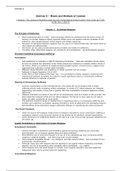Summary
Summary Means and Methods of War
- Institution
- The University Of Nottingham (UON)
This summary considers the means and methods of combat. We will consider the approaches taken by international humanitarian law to these issues, paying due attention to the principles of distinction and unnecessary suffering.
[Show more]



